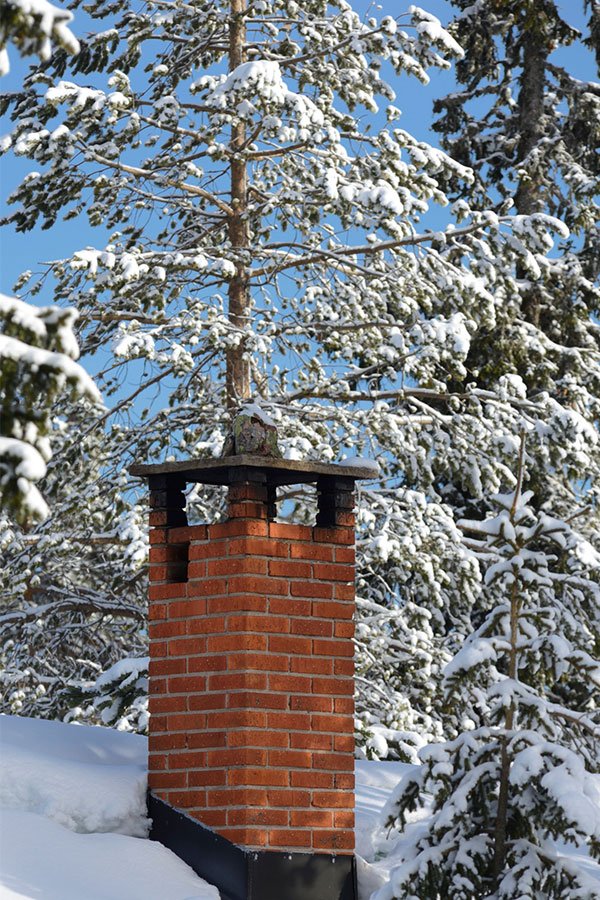Should You Start a Fire With a Cold Chimney?
When the weather turns cold, the first thing many homeowners want to do is to light the fire. Unfortunately, when the weather is cold and the house is cold, the chimney is also cold! Oftentimes when the house is warm from central heating, the chimney is still cold, filled with frigid air that is like a block in the chimney.
The Problem with Cold Flues
In order for air to rise, it must be warmer than the air around it. When the chimney is filled with cold air, the air from the fire has to fight to get through, creating a smoky fireplace and an inefficient chimney system. When you open your fireplace for the first fire of the season, you may notice a large cold draft coming from the fireplace opening when you open the doors or damper for the first time. This air will fall into your home and keep coming because cold air falls. As this cold air pushes down, it is difficult for the fire’s heat to push up. The fire will burn inefficiently unless you take measures to warm up, or prime, the flue.
Priming the Flue
To warm up your flue, start by finding a rolled newspaper or other thickly rolled paper. Open your flue and light the end of the papers, holding the flame at the throat of the chimney. This stream of heat will be hot and concentrated and will move its way through the chimney, warming it as it goes. By the time the roll is completely burned, the fire should be ready to light and will vent properly. It’s important to build a proper fire with the best firewood in order to warm up the flue completely and enjoy a fire for a long cold evening.
Building Your Fire
Start with properly seasoned firewood that will light well and burn efficiently. This means the wood was cut to length and set aside to dry for 3-6 months before the burn season. Some harder species of wood will need longer to dry, even up to 12 months. You can tell your wood is ready for your fire when the wood pieces are lighter in weight, make a hollow noise when two pieces are hit together, and when the bark pulls away from the wood. The flesh of the wood will also feel dry and begin to crack. This wood is the best for burning because it will burn completely and efficiently so your fire will burn at a higher temperature and waste less wood.
Build a more efficient fire by building a top-burn fire. Start by lining the bottom of the fireplace with the largest pieces of firewood lying front to back, each an inch apart.
Next, lay smaller pieces of firewood in one layer across the largest, each an inch apart.
Continue in the same manner with the next layer of wood smaller than the last. Three or four layers of wood are enough and your complete fire should not reach above the opening of your fireplace, insert, or stove. The final layer should be the kindling of the most seasoned wood, cut no more than an inch thick and topped with tinder.
At the top of your top-down fire, your tinder should be made up of lint or small strips of paper. This is easy to ignite and will help the kindling beneath it light and burn. The top-down fire is the most efficient and recommended by professionals across many industries. The idea is that instead of the fire fighting for air, it has plenty of oxygen at the top of the wood. Then the flame and embers fall by gravity onto the wood below. This takes the traditional fire-building we’ve all known for generations and turns it on its head—literally! When you build an upside-down fire, it will be easier to light, will burn more efficiently, and will get up to the desired temperature faster.
When your chimney is on the outer edge of your home, you can bet that cold weather will affect it. You must prime your flue before attempting to light a fire. Not doing so could cause smoke to flow back out into your home. A smoky fire can lead to respiratory issues as well as carbon monoxide exposure. If you've done everything above properly, but are still experiencing smoke or draft problems, check out our troubleshooting page in order to figure out if you have an obstruction or some other issue. If your smoky fireplace continues, it may be time to call a professional.
Comprehensive Chimney Care and Diagnostics in Northern California
If you reside in the Chico or Redding area, you can put your trust in White Glove Chimney and Air Duct when your fireplace is drafty or smoky. We clean, inspect, repair, and service every chimney regardless of age, size, or fuel type. We even service wall furnaces and do hearth installation, as well as a variety of duct repairs and vent services.
If you haven’t had your chimney inspected or cleaned since last winter, it’s important to do it now. Reach out with a phone call or schedule an appointment online.

